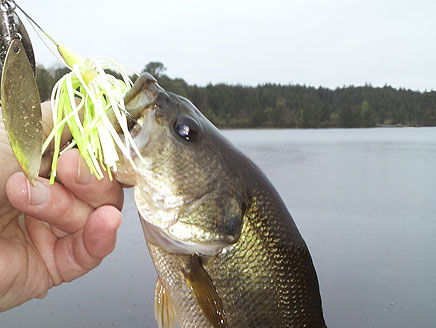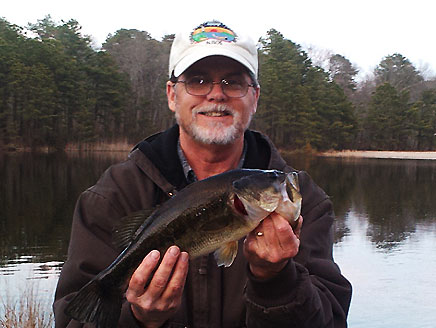

New Jersey's spring Pre-Spawn Largemouths can give you the best action of the entire year!
by Tom Vassallo
Every spring when the magnolias start to bloom and just before the dogwood flowers are out, I know that it's time to dust off the freshwater rods and tune-up the spinnerbaits. That's because in my neck of the woods (Waretown...Ocean County) I know it is LARGEMOUTH time. I must admit I used to be a hard core pickerel guy, but for quite a few years I've had the "bass bug" BAD! However, where I could always count on catching pickerel in just about ANY water temperature...including through the ice...I learned early that largemouth bass are quite a bit more picky when it comes to water temperature. My favorite spot is a shallow lake that is quite small. That sometimes has advantages when trying to locate fish. However, shallow bodies of water are much more susceptible to moderate changes in the weather, and those small changes can have a BIG effect on the bass bite.
Early spring can be a great time to catch Jersey largemouths. I have always had much more success in the spring than at other times of the year. Bass begin to become active and move out of deeper water when the water temperature gets to be about 45 degrees. This time of the spring season is your "pre-spawn". Fish are initially a lot less active and feed less often during this initial move from the deeper water. I find that at that time of the year, live minnows or killies may work, but they need to be fished similar to plastics...slow and close to or on the bottom. In the colder waters of early spring, I have actually had better success fishing dark, floating swimmers around nightfall. Fish them SLOW, with a stop and retrieve...just at or just below the surface. I have had these smaller fish actually knock that lure into the air, even this early in the season. Interestingly, I always seem to catch smaller bass on those topwater lures. Now I am no scientist, but I feel that these smaller fish just "warm up" a lot faster in the spring than the larger fish. Therefore, they will be the first to move into the shallower water to feed.
 |
| Pre-spawn males get very aggressive during the pre-spawn. They will attack much larger lures than most anglers would believe. Notice the two large willow blades and spinnerbait body are larger than this little guy's head! |
As the water temperature begins to climb along with the first few warm days of spring, the fish seem to get more plentiful very quickly and the size of the fish begins to increase. The water temperatures will fluctuate quite rapidly if a cool front moves through or if there is rain. Depending on the temperature of the rainwater, it can actually warm the water faster than a sunny day! I have had a great day with over a half dozen fish and the very next day after a chilly night...you can't seem to buy a bite. Yet, I have done very well with live bait and the old red and white plastic bobber at this time of the year. I prefer killies as they are easy to catch in the bay marshes and they should be hooked through the lower lip, NOT behind the dorsal fin. Since the water is still fairly cold at this point, it is important to let that bobber go DOWN before tightening your line. Once you feel the fish, a good yank is needed to set the hook. A SHARP hook is essential to pierce that upper jaw.
However, my favorite spring lure is without a doubt, the spinnerbait. I prefer a large ½ oz white, chartreuse or white/chartreuse blend when fishing early or late morning. I like double blades and I actually used to prefer willow blades on top and bottom. But lately I will primarily use a colorado and willow which is what you will usually be able to find on the shelf. I fish stained water and prefer clouds or light rain. I also feel the best conditions for big spinnerbaits is when there is just enough wind to create a light ripple on the surface in the rain. Many bass anglers swear by a slow retrieve, but my technique which has been very successful for me is a rapid retrieve, pause and repeat. I try to keep the blades just under the surface and sometimes even break the surface to create an occasional splash or gurgle. I think this retrieve uses both sight and noise to excite fish or trick them into believing that the lure is being pursued by a smaller fish. I believe that is why I catch bigger fish using this technique. Here's a little tip for when you get closer to summer...try a black spinnerbait with a single large colorado blade around dusk after a thunderstorm or heavy rain around pipes and the mouth of feeder creeks...and be ready for some action!
 |
| The author holds a nice pre-spawn bass. Notice the darker color of the bass when they first move out of the deeper water and into the shallows. This bass was taken on live bait. |
As the water temperature begins to climb along with the first few warm days of spring, the fish seem to get more plentiful very quickly and the size of the fish begins to increase. The water temperatures will fluctuate quite rapidly if a cool front moves through or if there is rain. Depending on the temperature of the rainwater, it can actually warm the water faster than a sunny day! I have had a great day with over a half dozen fish and the very next day after a chilly night...you can't seem to buy a bite. Yet, I have done very well with live bait and the old red and white plastic bobber at this time of the year. I prefer killies as they are easy to catch in the bay marshes and they should be hooked through the lower lip, NOT behind the dorsal fin. Since the water is still fairly cold at this point, it is important to let that bobber go DOWN before tightening your line. Once you feel the fish, a good yank is needed to set the hook. A SHARP hook is essential to pierce that upper jaw.
However, my favorite spring lure is without a doubt, the spinnerbait. I prefer a large ½ oz white, chartreuse or white/chartreuse blend when fishing early or late morning. I like double blades and I actually used to prefer willow blades on top and bottom. But lately I will primarily use a colorado and willow which is what you will usually be able to find on the shelf. I fish stained water and prefer clouds or light rain. I also feel the best conditions for big spinnerbaits is when there is just enough wind to create a light ripple on the surface in the rain. Many bass anglers swear by a slow retrieve, but my technique which has been very successful for me is a rapid retrieve, pause and repeat. I try to keep the blades just under the surface and sometimes even break the surface to create an occasional splash or gurgle. I think this retrieve uses both sight and noise to excite fish or trick them into believing that the lure is being pursued by a smaller fish. I believe that is why I catch bigger fish using this technique. Here's a little tip for when you get closer to summer...try a black spinnerbait with a single large colorado blade around dusk after a thunderstorm or heavy rain around pipes and the mouth of feeder creeks...and be ready for some action!
Once the water temperature rises to 55 degrees the spawn may begin. Since males are smaller fish, they are actively choosing nest sites and spending even more time in shallow water. The spawn is a much more difficult time to coax bass into biting. Many times you will miss fish as the smaller males are simply chasing or carrying the lure out of the nest. They can sometimes be coaxed into grabbing a senko, especially in a smaller size. I like the movement of this type of bait as it falls and prefer it over a plastic worm at this time of year. Many pros swear by a salamander during the spawn as it is supposed to anger and excite nesting bass. However, salamanders are rarely seen in the waters I fish and I have not had much success with one.
Try to keep on top of your water temperatures. They are the key to exciting Jersey largemouth fishing in the spring. You need to be particularly on top of those water temperatures when fishing shallow lakes and ponds. Once the pre-spawn bass bite stops in shallower waters, try fishing deeper, cooler lakes that will warm much more slowly. This will extend and optimize your "pre-spawn" time and you'll be catching more early spring Jersey bass...now get out there and fish!














